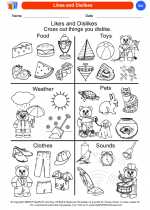Reproduction
Reproduction is the biological process by which new individual organisms are produced from their parent organisms. It is a fundamental characteristic of all living beings and is essential for the continuation of a species.
Types of Reproduction
There are two main types of reproduction:
- Asexual Reproduction: This type of reproduction involves a single parent and does not involve the fusion of gametes. The offspring produced are genetically identical to the parent.
- Sexual Reproduction: In this type of reproduction, two parents contribute genetic material to produce offspring. The offspring are genetically different from the parents due to the combination of genetic material from both parents.
Importance of Reproduction
Reproduction is crucial for the survival and continuation of a species. It allows for genetic diversity, adaptation to changing environments, and the perpetuation of desirable traits within a population.
Study Guide
Here are some key points to remember when studying the topic of reproduction:
- Define reproduction and explain its significance in the natural world.
- Differentiate between asexual and sexual reproduction, providing examples of each.
- Discuss the advantages and disadvantages of both types of reproduction.
- Explain the role of DNA and genetic material in the process of reproduction.
- Describe the life cycle of a typical organism, highlighting the reproductive stages.
Understanding the process of reproduction is essential for comprehending the mechanisms by which life is sustained and propagated on Earth.
[Reproduction] Related Worksheets and Study Guides:
.◂Science Worksheets and Study Guides Kindergarten. Me and My Family
Coloring Worksheet All About Me
All About Me  Coloring Worksheet
Coloring Worksheet All About Me
All About Me  Coloring Worksheet
Coloring Worksheet Basic Needs Clothing
Basic Needs Clothing  Coloring Worksheet
Coloring Worksheet Basic Needs Clothing
Basic Needs Clothing  Coloring Worksheet
Coloring Worksheet Basic Needs Food and Water
Basic Needs Food and Water  Coloring Worksheet
Coloring Worksheet Basic Needs Food and Water
Basic Needs Food and Water  Coloring Worksheet
Coloring Worksheet Basic Needs Shelter
Basic Needs Shelter  Coloring Worksheet
Coloring Worksheet Basic Needs Shelter
Basic Needs Shelter  Coloring Worksheet
Coloring Worksheet Family Tree
Family Tree  Coloring Worksheet
Coloring Worksheet Family Tree
Family Tree  Coloring Worksheet
Coloring Worksheet How are Families Different
How are Families Different  Coloring Worksheet
Coloring Worksheet How are Families Different
How are Families Different  Coloring Worksheet
Coloring Worksheet How are Families the Same
How are Families the Same  Coloring Worksheet
Coloring Worksheet How are Families the Same
How are Families the Same  Coloring Worksheet
Coloring Worksheet Likes and Dislikes
Likes and Dislikes  Coloring Worksheet
Coloring Worksheet Likes and Dislikes
Likes and Dislikes  Coloring Worksheet
Coloring Worksheet Needs and Wants
Needs and Wants  Coloring Worksheet
Coloring Worksheet Needs and Wants
Needs and Wants  Coloring Worksheet
Coloring Worksheet Traditions and Celebrations
Traditions and Celebrations  Coloring Worksheet
Coloring Worksheet Traditions and Celebrations
Traditions and Celebrations 

 Coloring Worksheet
Coloring Worksheet
 Coloring Worksheet
Coloring Worksheet
 Coloring Worksheet
Coloring Worksheet
 Coloring Worksheet
Coloring Worksheet
 Coloring Worksheet
Coloring Worksheet
 Coloring Worksheet
Coloring Worksheet
 Coloring Worksheet
Coloring Worksheet
 Coloring Worksheet
Coloring Worksheet
 Coloring Worksheet
Coloring Worksheet
 Coloring Worksheet
Coloring Worksheet
 Coloring Worksheet
Coloring Worksheet
 Coloring Worksheet
Coloring Worksheet
 Coloring Worksheet
Coloring Worksheet
 Coloring Worksheet
Coloring Worksheet
 Coloring Worksheet
Coloring Worksheet
 Coloring Worksheet
Coloring Worksheet
 Coloring Worksheet
Coloring Worksheet
 Coloring Worksheet
Coloring Worksheet
 Coloring Worksheet
Coloring Worksheet
